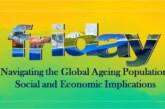Feeding the World
By Dr Arvind Kumar
With upwards of two billion extra mouths to feed in the coming decades, food security has become a mantra in debates throughout the globe. The UN estimates one-in-seven people do not have enough food to eat today, and analysts say nourishing the anticipated 9 billion earthlings by mid-century poses a clear challenge – especially for finding a balance between production and the ecology. According to Joachim Lammel, a lead researcher for the Norwegian-based Yara fertiliser company, “The solution is beyond individual companies, it’s probably even beyond individual countries. It’s not a question of lack of technical knowledge, it’s absolutely doable. But it requires that more focus and attention is put behind this challenge.
Machinery, nutrients, pesticides and irrigation technology helped feed the post-war baby boom, and continuing advances could lift yields in parts of the world expecting the biggest population growth in this century, namely Sub-Saharan Africa and South Asia. But such farming has consequences for the environment. The UN Food and Agricultyral Organization (FAO) forecasts a 70% rise in global agricultural demand by 2050 – and a doubling of need in low- and middle-income countries – while warning that climate change, unsustainable water use and deteriorating soil quality threaten future food production. In another warning about looming resource threats, the Organisation for Economic Cooperation and Development says in a new report that intensified farming to feed a more crowded planet will threaten freshwater supplies.
UN Secretary-General Ban Ki-moon’s advice is worth heeding: “Producing enough food to feed the world’s rapidly growing population will require ensuring the sustainable use of water; unless we increase our capacity to use water wisely in agriculture, we will fail to end hunger and we will open the door to a range of other ills, including drought, famine and political instability.”




